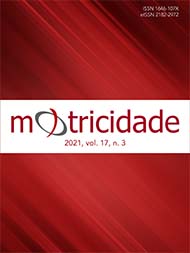Supine-to-Stand task analysis in healthy older adults
DOI:
https://doi.org/10.6063/motricidade.19628Keywords:
activities of daily living, motor skills, geriatric assessment, frail elderly, agedAbstract
Supine-To-Stand task is considered a developmental milestone, useful, valid, and reliable means of tracking functional motor competence. Concerning the elderly, the diversity of protocols used for Supine-To-Stand analysis requires rigorous examination. This study aimed to determine the protocol with the greatest methodological advantage for analyzing the Supine-To-Stand task process of older adults, both sexes and aged ≥ 60 years. A systematic review was carried out on the process analysis protocols of the Supine-To-Stand task. The application of criteria (clarity of language, exemption from floor and ceiling effect, reproducibility and satisfactory reliability, detail of the task, coding time) and the attribution of scores that added together allowed to classify the protocols according to the level of methodological advantage: greater (Σ≥ 10), median (Σ between 6–9) or less (Σ≤ 5), allowed the selection of the protocol with the greatest methodological advantage. The results showed that all protocols were considered to be at least of medium advantage. The protocol proposed by Manini et al. presented greater methodological advantage (Σ= 10), allowing us to conclude that this protocol is the most suitable for analyzing the Supine-To-Stand process in the elderly, especially for presenting excellent performance in language clarity, low coding time, being free of floor or ceiling effect, being reproducible and reliable.
Keywords: activities of daily living; motor skills; geriatric assessment; frail elderly; aged
Downloads
Published
Issue
Section
License
The authors of submitted manuscripts must transfer the full copyright to Journal Motricidade / Sílabas Didáticas Editions. Granting copyright permission allows the publication and dissemination of the article in printed or electronic formats, and copyrights start at the moment the manuscript is accepted for publication. It also allows Journal Motricidade to use and commercialise the article in terms of licensing, lending or selling its content to indexation/abstracts databases and other entities.
According to the terms of the Creative Commons licence, authors may reproduce a reasonable number of copies for personal or professional purposes, but without any economic gain. SHERPA/RoMEO allows authors to post a final digital copy (post-printing version) of the article on their websites or on their institutions' scientific repository.


